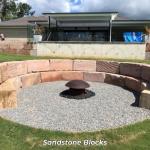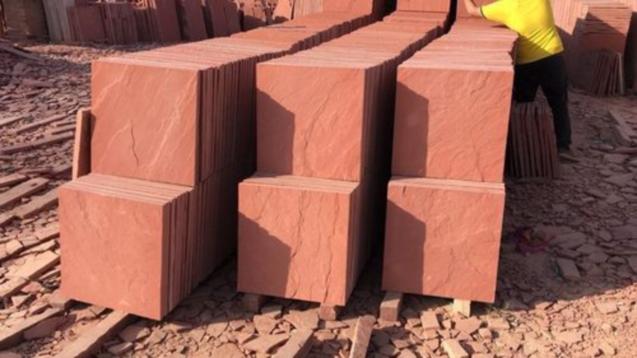
Sandstone 101 | Advantages of Installing It In Your Home Brisbane & Perth
Using sandstone in Brisbane will let your house stand out from the rest of the neighborhood whether you are looking to change the pavers, install a retaining wall, or add a wall cladding.
What is Sandstone?
Sandstone is sedimentary sand or quartz fused until it has formed a rock. Its natural color range from yellow, red, to brown. All sedimentary rocks contain about a quarter of sandstone, among other materials.
Sandstone is a common mineral found in Australia, so it is just waiting to be harnessed and converted into a showpiece in your home.
Where do you use sandstone?
Sandstone is a versatile material. It can be utilized as a replacement for other building and construction materials such as concrete. There are many uses for sandstone. For example, you can put it on the pavement, interior or exterior walls, and liners for your iron furnace. You can also enhance your terrace or fence with sandstone slabs or elevate the design of your fireplace.
Not many people know it, but the material is also used to make fiberglass, computer chips, and TV screens. If you have seen trap sand on the golf course, you may be surprised that some companies also use sandstone for the material.
Is it expensive to install sandstone in your home?
The price depends on whether you install sandstone for the cladding, retaining wall, or as a paver. For instance, pavers start at $25 per square meter. But it can also go as high as $60 per square meter if you install buffed sandstone, known for its non-slippery smooth surface.
In terms of labour for installing a cladding, the cost starts at A$50 per hour. On the other hand, a retaining wall is much more expensive since it will run $300 to $600 per square meter. With that said, it's still cheaper than reinforced concrete blocks.
If you have some broken-down vehicles around, you can get extra money by going to a cash for cars dealer. You do not even have to fix or clean the scrap car before the dealership hauls it away. Instead, they will take the problem out of your hands.
That means you do not have to look at the eyesore anymore. Meanwhile, the money you earn from selling your car can buy sandstone and pay for the installation labor.
Some Additional Tips When Choosing to Install Sandstone in Your Home
Considering that sandstone is difficult to work with, we are providing you with tips on how to install them. These include the following:
Install with purpose — Use it lightly to enhance its features and create a dramatic contrast from the rest of the materials in your home. By installing with a clear goal, you highlight its natural elegance and make a conversation starter with your guests.
Face the sun — When installing sandstone cladding, ensure that it faces the sun through most of the day. Not only will it create a dramatic effect when the rays hit just right, but you also extend the material's lifespan. Sandstone will likely become moldy under the shade. It is also vulnerable to discoloration when kept away from sunlight.
Keep away from water as much as possible — You can still add sandstone around your pool or bathroom, but you need to be strategic about the placement. Pool water contains chlorine, which will damage the surface of the sedimentary rock.
Enhance with the right color — The natural color of sandstone ranges from yellow, brown, and red. You can create warmth in your house by playing around with the same palette of yellow, crimson, or coffee.
You can also mix the rough texture with smooth materials to add visual appeal. Sandstone works with most materials but stands out with concrete and wood.
Australia has a large sandstone deposit, but it's primarily overlooked as home decor because of some misconceptions. For instance, some homeowners tend to compare sandstone against marble or granite in terms of cost.
While sandstone may be more costly than concrete, it is more affordable than granite. Also, people mistakenly assume that sandstone is highly porous, so it breaks down quickly. But sandstone pavers have a lifespan of 30 to 50 years with the right installer and maintenance.
What is Sandstone?
Sandstone is sedimentary sand or quartz fused until it has formed a rock. Its natural color range from yellow, red, to brown. All sedimentary rocks contain about a quarter of sandstone, among other materials.
Sandstone is a common mineral found in Australia, so it is just waiting to be harnessed and converted into a showpiece in your home.
Where do you use sandstone?
Sandstone is a versatile material. It can be utilized as a replacement for other building and construction materials such as concrete. There are many uses for sandstone. For example, you can put it on the pavement, interior or exterior walls, and liners for your iron furnace. You can also enhance your terrace or fence with sandstone slabs or elevate the design of your fireplace.
Not many people know it, but the material is also used to make fiberglass, computer chips, and TV screens. If you have seen trap sand on the golf course, you may be surprised that some companies also use sandstone for the material.
Is it expensive to install sandstone in your home?
The price depends on whether you install sandstone for the cladding, retaining wall, or as a paver. For instance, pavers start at $25 per square meter. But it can also go as high as $60 per square meter if you install buffed sandstone, known for its non-slippery smooth surface.
In terms of labour for installing a cladding, the cost starts at A$50 per hour. On the other hand, a retaining wall is much more expensive since it will run $300 to $600 per square meter. With that said, it's still cheaper than reinforced concrete blocks.
If you have some broken-down vehicles around, you can get extra money by going to a cash for cars dealer. You do not even have to fix or clean the scrap car before the dealership hauls it away. Instead, they will take the problem out of your hands.
That means you do not have to look at the eyesore anymore. Meanwhile, the money you earn from selling your car can buy sandstone and pay for the installation labor.
Some Additional Tips When Choosing to Install Sandstone in Your Home
Considering that sandstone is difficult to work with, we are providing you with tips on how to install them. These include the following:
Install with purpose — Use it lightly to enhance its features and create a dramatic contrast from the rest of the materials in your home. By installing with a clear goal, you highlight its natural elegance and make a conversation starter with your guests.
Face the sun — When installing sandstone cladding, ensure that it faces the sun through most of the day. Not only will it create a dramatic effect when the rays hit just right, but you also extend the material's lifespan. Sandstone will likely become moldy under the shade. It is also vulnerable to discoloration when kept away from sunlight.
Keep away from water as much as possible — You can still add sandstone around your pool or bathroom, but you need to be strategic about the placement. Pool water contains chlorine, which will damage the surface of the sedimentary rock.
Enhance with the right color — The natural color of sandstone ranges from yellow, brown, and red. You can create warmth in your house by playing around with the same palette of yellow, crimson, or coffee.
You can also mix the rough texture with smooth materials to add visual appeal. Sandstone works with most materials but stands out with concrete and wood.
Australia has a large sandstone deposit, but it's primarily overlooked as home decor because of some misconceptions. For instance, some homeowners tend to compare sandstone against marble or granite in terms of cost.
While sandstone may be more costly than concrete, it is more affordable than granite. Also, people mistakenly assume that sandstone is highly porous, so it breaks down quickly. But sandstone pavers have a lifespan of 30 to 50 years with the right installer and maintenance.

